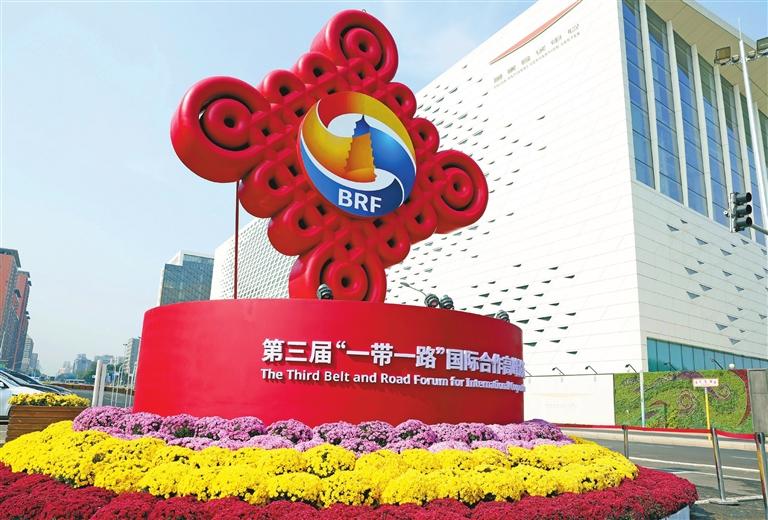
Zhang Yu JeniZhang13@163.com THE Shenzhen x Lancang-Mekong Initiative, a program launched in 2017, has been written into a white paper titled “The Belt and Road Initiative: A Key Pillar of the Global Community of Shared Future” released by the State Council Information Office on Oct. 10. As per the white paper, under the Belt and Road Initiative (BRI) framework, nongovernmental organizations have been providing benefits for the people, improving their well-being and enhancing people-to-people exchanges, while continuously weaving a network of cooperation. The paper mentioned that projects, such as the Shenzhen x Lancang-Mekong Initiative, have had a wide-ranging impact. The white paper aims to give the international community a better understanding of the value of the BRI, facilitate high-quality cooperation under it and ultimately deliver benefits to more countries and people. The BRI, announced by China 10 years ago with poverty reduction as its priority, has galvanized nearly US$1 trillion of investment globally and lifted 40 million people out of poverty, Foreign Ministry spokesperson Mao Ning said yesterday. SZ experience plays a role Since its launch, the BRI has evolved “from ideas into actions, from a vision into reality, and from a general framework into concrete projects,” according to the white paper. “It has been welcomed by the international community both as a public good and a cooperation platform.” The Shenzhen x Lancang-Mekong Initiative serves a model project by nongovernmental organizations aiming to improve people’s well-being. Within the Lancang-Mekong Cooperation (LMC) framework, the Shenzhen Foundation for International Exchange and Cooperation (SFIEC) has been collaborating with Shenzhen enterprises, universities, think tanks and social organizations to work on the Shenzhen x Lancang-Mekong Initiative since 2017. The initiative’s four initial projects are Special Economic Zone Experience Sharing, Mekong River Sunlight Villages, Mekong River Brightness Action — Cataract Cure, and Genetic Screening for Thalassemia and Deafness. According to SFIEC, the projects endeavor to bring new inspiration to the sustainable socioeconomic development of countries downstream of the Mekong River with Shenzhen’s experience, and improve the daily lives of local people with Shenzhen products and advanced technologies. As part of the initiative, a project of hearing loss genetic testing and hearing aids donation was launched in Shenzhen in April and Laos last week to help impoverished people with hearing difficulties in Laos. “Shenzhen is an advanced metropolis and a pioneer in China’s reform and opening up. Its participation would foster cooperation among the six LMC nations,” Vanhpheng Saisomphou, consul general of the Laos in Guangzhou, said at the project’s launch ceremony in Shenzhen this April. Saisomphou added that Laos will work with Shenzhen to achieve more fruitful results. With the help of the Lao Red Cross, Shenzhen will perform hearing loss genetic testing, free of charge, for 300 individuals from families with hereditary hearing impairment in Vientiane, capital of Laos. At the same time, hearing aids will be distributed to 100 impoverished people with hearing impairment. People-to-people connectivity “Although nongovernmental forces are relatively smaller, they can touch people’s hearts,” Mei Xin, deputy secretary general of the Yu Pengnian Charity Foundation, who has participated in the Shenzhen x Lancang-Mekong Initiative, said. In August 2018, the SFIEC and Cambodia’s Civil Society Alliance Forum jointly carried out the Mekong River Sunlight Villages project, installing 300 sets of offline photovoltaic power generation equipment, 100 sets of solar energy learning lights and 10 sets of solar TV and antenna in two counties of Cambodia’s Takeo Province. The installation helped 300 impoverished households and some schools and hospitals gain access to stable power use. Teak Sokheng is a beneficiary of the project, who lives by herself as her son works in Phnom Penh. When the project’s staffers revisited her, she said that she can charge her phone without leaving home and contact her son more often, thanks to solar energy. The Shenzhen x Lancang-Mekong Initiative is also committed to lighting up the world of eye disease patients. The Mekong River Brightness Action — Cataract Cure project organizes ophthalmic medical teams to go to Mekong River countries and subsidizes local professional medical institutions to carry out cataract surgery or other ophthalmic disease screenings for Cambodians. As of March 2022, the project had arranged 17 mass screenings, offered free cataract surgeries for 150 impoverished patients, and gave refractive glasses to 500 residents suffering from vision problems, according to the SFIEC. (More on P4, 6, 8) | 
